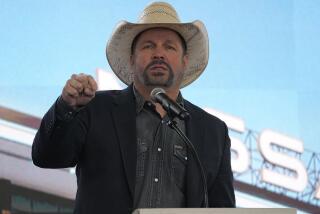‘Accused’: The Raped and the Rapists
The scene is the back game room of a graffiti-covered bar off a main road, and the focal point is the pinball machine with its headboard depicting a scantily clad woman half-plopped in a basketball hoop.
Moments before, the machine was used for playing games. Now it is the table upon which a woman is repeatedly and systematically being raped.
The scene is from “The Accused,” the new movie starring Jodie Foster as Sarah Tobias, a waitress with a blue-collar accent who lives in a trailer, and Kelly McGillis as Kathryn Murphy, the yuppie assistant district attorney who is assigned to prosecute the men who attacked Tobias.
The movie’s title also applies to the victim who, Murphy explains, will be asked on the witness stand such questions as whether she likes being hit or wears underwear.
In “The Accused” (opening Friday), Tobias strides into The Mill, looking, as one bar patron later recalls, “really sexy.” She is wearing a short jeans skirt and a skimpy halter top. She has a couple of drinks with her girlfriend, who is a waitress there, and smokes some grass.
She attracts the attention of a man called Danny, and they dance close. He kisses her. She wants to stop. “Let go!” she insists.
He doesn’t, and rudely hoists her on the pinball machine, her legs splayed like a discarded rag doll. He rapes her and so do two other men while three more hoot and clap as if at a sporting event: “Go! Go! . . . More! More!”
There are no weapons except for strong hands over a woman’s mouth and throat while other hands hold her down. There is no blood, just scratches and the beginning red marks of facial bruises that Gail Abarbanel, director of the Santa Monica Rape Treatment Center, says are often typical of those rape victims suffer.
There is hardly any nudity, except for a flash of breast and the ugliness of the attackers’ bare behinds. Yet the brutality of the scene, which lasts about three minutes but seems a lot longer, is evident.
Set in Washington state and filmed in Vancouver, Canada, the movie calls to mind the March, 1983, gang rape of a woman on a pool table in Big Dan’s, a New Bedford, Mass., bar, while witnesses cheered, “Do it, do it!”
Several months after the New Bedford rape, co-producers Stanley R. Jaffe and Sherry Lansing (“Fatal Attraction”) hired writer Tom Topor (who wrote the play “Nuts” and co-wrote the movie). But there the parallels between “The Accused” and the way the actual incident end.
“The first hour of the movie, they’re judging me,” says Jodie Foster of the audience’s view of Tobias, “and that’s what it’s supposed to be. They judge based on the facts they’ve received--deciding whether I deserve it, or whether I have a case. Could rape be justified?
“And once you get to the last 20 minutes of the movie, it makes you feel horrible that you even had that question. Can you ever in your mind entertain the thought that anyone deserves to be raped, that anyone deserves to have their will taken away from them . . . (to be) treated like an object or a piece of wood?”
The deep-voiced 25-year-old Yale graduate, who has made 26 movies, is sitting in Jaffe’s office at Paramount, the same room where she read for the role last year. She is wearing a black turtleneck sweater, muted silk plaid pants, black loafers and tortoise-shell granny glasses over bright blue eyes.
Gone are the broken blood vessels in her right eye that she got last year from crying during shooting of the rape scene. Gone too is the blue-collar cadence of her speech, except when something provokes her and she merges momentarily into her character.
“What does dress have to do with violence?” she asks. “Dressing and violence, they have nothing to say to each other. Violence has to do with a halter top? . . . I don’t understand it personally. Why would you want to hurt something that’s attractive to you?”
Foster, who became the object of John W. Hinckley Jr.’s obsessions, probably understands the bizarre connection between attraction and violence all too well. The man who shot President Reagan in March, 1981, said he wanted to impress Foster. As it came out at the trial, Hinckley stalked Foster at Yale with a gun in the weeks before he shot the President.
There is a facade of openness about Foster. She swings her legs over a chair and looks directly at her interviewer, casting an occasional glance at the reporter’s notebook. But she refuses to discuss the Hinckley part of her past even as it might relate to preparing for her role as a victim.
“I don’t talk about that in any way, shape or form,” Foster says evenly, “but I understand what you just said.” She pauses. “You can quote yourself.”
Foster, who was memorable as the 12-year-old prostitute in “Taxi Driver,” appreciates Tobias not only as “the juiciest part I’ve ever encountered” but for her character.
“She walks into that bar after having a fight with her boyfriend, and she feels good about herself. She’s just like one of the guys but she also retains her femininity and she’s very sensual. Someone comes on to her, she dances to her favorite song by herself in a very unself-conscious way, and she forgets that there’s danger. Or maybe she never knew it. The dancing scene is the apex of will in a lot of ways, and within five seconds it is gone.
“And the rest of the movie is really about the process of trying to regain that sense of will,” Foster added, “and to tell her story. . . . For if she can tell her story and get a guilty verdict, it means her scars are not invalidated, they’re real, the experience was real, and she can get over it. . . .
“She’s incredibly pure,” Foster says of Tobias. “She may be a pain, or she may say stupid things or sometimes she’s not in command of her language . . . but she’s not manipulative and she says what she means, and even when she doesn’t, it’s so obvious from what’s going on in her face that her act of bravado is just that.”
At one point, Foster says she simply read newspaper articles and talked to rape clinicians to prepare for the role.
“I didn’t draw from anything from within myself. I spoke the words and did the actions. That’s what acting is.”
A moment later she appears to correct herself. She says she learned for the first time from the movie to go more into her emotions. “This was the catalyst.”
The gang rape in New Bedford, said Sherry Lansing, “got us thinking,” but the movie is “not New Bedford.” It is hardly documentary.
In the actual case, six men, Portuguese immigrants, were brought to trial on charges of aggravated rape. Four were convicted but two were acquitted after evidence that neither man assaulted the victim, although there was testimony they cheered and yelled encouragement.
The victim, who later died in an automobile crash in Florida, was also of Portuguese descent.
In the movie, there is a plea bargain for a reduced charge for the rapists because Tobias has been judged by Murphy as being unable to make a good witness. The rapists are of no particular ethnic or sociological group; one of the three--deliberately implying the increased incidence of rape on college campuses--is a college fraternity member.
Murphy later changes her mind about Tobias, and brings the witnesses to trial on grounds of “criminal solicitation,” of “commanding, inducing, entreating” rape, of egging it on.
For Lansing and Topor, “The Accused” had germinations besides New Bedford.
“They were all in my head,” said Lansing. “Nazi Germany, Kitty Genovese, this .”
Both vividly recall what happened to Genovese, the young New York woman who was stabbed to death in 1964 outside her apartment building while 38 people who heard her screams silently watched and did nothing. Lansing and Topor are also children of mothers who fled Germany and Austria respectively, just ahead of the Holocaust.
“My whole life I’ve been fascinated with doing a movie about the culpability of the bystanders, about the responsibility of people who witness something happening,” Lansing said.
“And then when Stanley and I started to do research about rape, we realized much to our surprise and horror that incidents like New Bedford happen thousands of times every year, whether it’s in a bar, in a courtyard or the epidemic on college campuses where gang rape is almost a rite of passage among fraternity members.”
Topor said he stayed “at arm’s length from the case. I didn’t want to get cluttered up with it.” What interested him was where would those “encouraging the crime be legally?”
“To me the movie is about the Holocaust,” added Topor. “What happens when the storm troopers come and bang on your door, and your neighbors either look the other way or cheer them on? . . . Vileness only happens when supposedly decent people avert their eyes or encourage it.”
To director Jonathan Kaplan, “The Accused” is about complicity, about the “insidious” attitude of “blame the victim. There is an overwhelming atmosphere today that blames poor people for their poverty, homeless people for their homelessness, AIDS victims for AIDS, rape victims for being raped.”
Although the rape scene comes toward the end of the movie as a flashback during the trial, Kaplan deliberately shot it first because “it happens chronologically in the beginning, and therefore Jodie experiences it in the picture. I wanted her to have it in her mind as vividly as possible. There’s a rage she’s playing that you only can get (that way).”
He said a lot of actresses were interested in the part, “and every one of them brought up the rape scene in advance, and she (Foster) never mentioned it. Either she was totally together about it--or she just wasn’t dealing with it.”
The rape scene was shot over five days on a closed set.
“I was surprised by how affected I was,” Foster says. Although afterward she helped comfort the men, she cannot recall what she was thinking while she was on the pinball machine. “I blanked out.
“Those first two weeks were rough on everyone,” adds Foster. “People were like getting divorces and really having trouble at home, not sleeping, not being able to eat, and everybody was walking on eggs. It was awful. . . . I was more emotionally involved than I’ve ever been before. I lived that experience in a way that I had never lived anything on screen.”
At what point does rape begin?
Foster is told that someone closely connected to “The Accused” suggests it’s not that moment when her character says “Let go!” but the point at which force is used, when hands go over her mouth. Foster becomes visibly angry:
“It’s very hard for me as an actor, because I was there. I don’t care what (he) says. He wasn’t on the table with me. Everybody can have an opinion as much as they want, but I was there. I’m not a bumbling weepy woman obsessed with Method acting, but never, not in my conscious memory, have I ever been so totally stripped of my will.
“I acted it,” Foster adds a few moments later, saying she can’t compare it to being an actual rape victim. “I could always leave .”
More to Read
Only good movies
Get the Indie Focus newsletter, Mark Olsen's weekly guide to the world of cinema.
You may occasionally receive promotional content from the Los Angeles Times.










